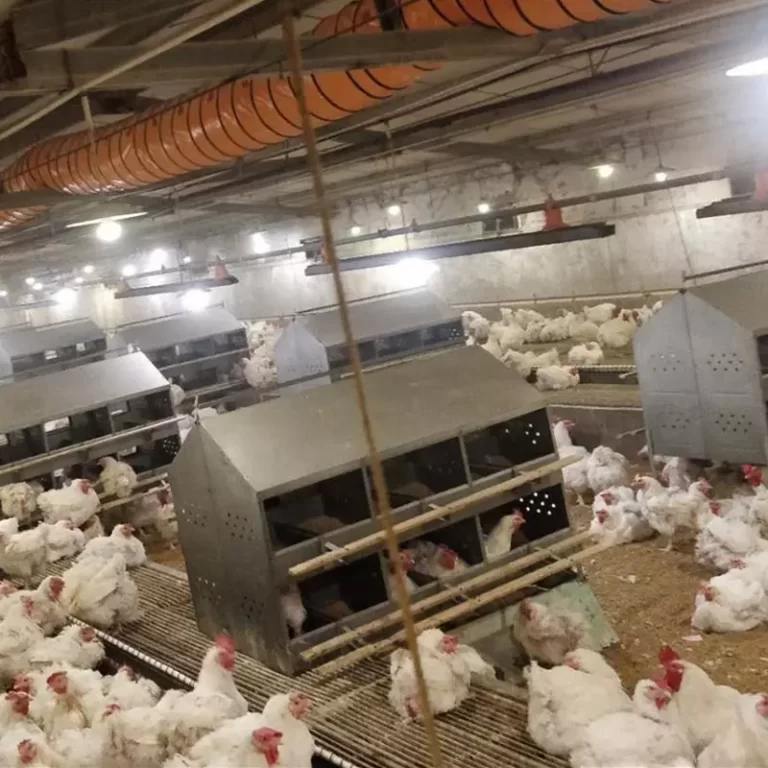Lighting Knowledge Required for Poultry Farming

The reproductive cycle of poultry was originally entirely seasonal, being active during spring and summer and dormant during autumn and winter. This phenomenon was caused by the duration of daily sunlight. When the daily exposure to sunlight exceeds 12 hours, it promotes sexual maturity in chickens. Interestingly, the parts of the chicken stimulated by this light are not the eyes but the pituitary gland in the brain; light only enters the pituitary gland through the eyes and skull. Even chickens that are completely blind can perceive the stimulation from light.
When chickens transition from brief exposure to sunlight to longer exposure (12 hours or more) daily, it triggers the secretion of hormones that facilitate the development of the ovaries or testes. In hens, the small, pale follicles gradually turn yellow (due to increased fat content), and these follicles also secrete some female hormones, playing a role in promoting maturity and egg production. Additionally, the liver enlarges, its color shifting from dark black-brown to light brown due to the increased lipid content needed to produce a large amount of egg yolk for the development and maturation of follicles. Female hormones also cause the reproductive tract to enlarge, enabling the oviduct to accept matured egg yolks and facilitate the production of eggs. Apart from female hormones, hens also secrete some male hormones. Both hormones together change the shape, size, and color of the comb of the chicken and encourage hens to accept closeness and mating with roosters.
Another aspect often discussed is the intensity of light. Similar to the duration, there’s a minimal value for light intensity that stimulates chickens. The minimum threshold for daylight duration is 12 hours; for light intensity, it’s 10.8 lux or 1 candlepower. As long as the daylight duration is over 12 hours and the intensity is above 1 candlepower, chickens receive the stimuli for sexual maturity. If more stimulation is needed, the duration of exposure needs gradual extension, but the light intensity can still be maintained at 10.8 lux (1 candlepower).
So, why do many recommend light intensities during the laying period to be between 32-65 lux (3-6 candlepower)? This is because modern intensive chicken houses are quite large, and the amount of light emitted by bulbs is often absorbed by the ceiling, walls, equipment, and utensils. Moreover, chicken houses generate a considerable amount of dust that covers the bulbs, or the bulbs themselves may be old, leading to only around half of the light actually reaching the ground. Additionally, light distribution is uneven; dim corners, areas under nesting boxes, etc., receive much less light. Some people paint chicken houses white to reflect light more evenly. Furthermore, using more bulbs with lower wattages evenly distributed can also enhance the effect.
Therefore, recommending 32-65 lux is practical and relatively safe. However, stronger light won’t increase productivity. On the contrary, excessive light can prompt aggressive, wild, or feather-pecking behavior in chickens. Therefore, for meat chickens that don’t need to promote sexual maturity, a maximum of only 1/2 candlepower is suggested; stronger light increases their activity, consuming more heat energy and resulting in poor feed conversion rates. For open-sided chicken houses, using black nylon nets to reduce light intensity is an option, although it might not be as effective as desired.
As mentioned, only about half of the light from bulbs reaches the ground. Therefore, when calculating bulb installations, multiply the chicken house area by 2 to ensure sufficient light intensity. For instance:
For a chicken house that’s 120 meters long, 12 meters wide, with an area of 1440 square meters, requiring a light intensity of 33 lux and each bulb being 100 watts (1600 lumens), how many bulbs are needed?
Answer: ([1440 \times 2 \times 33] / 1600 = 95040 / 1600 = 59.4 \approx 60)
Thus, a total of 60 bulbs of 100 watts each are needed. If arranged in two rows, the distance between each bulb and between the bulbs and the wall should be: (120 – (4 + 4) = 112) meters, (112 / 30 = 3.7 \approx 4) meters.
For calculating the light intensity of an existing chicken house:
Lux = (number of lights × lumens per bulb) / (2 × chicken house area in square meters)
Using the previous example: (60 \times 1600 / (2 \times 1400) = 96000 / 2880 = 33) lux
Note: 1 lumen = 5.4 lux = 0.5 candlepower.
The light exposure time for the flock can only be increased (with a limit of 18 hours); decreasing it might make hens believe that autumn and winter are approaching instinctively, leading to reduced egg production.
Natural sunlight is a comprehensive full spectrum, whereas artificial light has limitations in its spectrum. Various studies have shown different spectrums’ impacts on poultry. Here are some excerpts for reference:
Increase in body growth: Green, Blue.
Increase in sexual maturity: Red, Orange, Yellow.
Slowing down sexual maturity: Green, Blue.
Reduced nervousness: Red.
Reduced aggression in chickens: Red.
Increase in egg laying: Red, Orange.
Reduced egg laying: Yellow.
Increase in egg size: Yellow.
Increase in fertilization rate of rooster semen: Green, Blue.
Reduced fertilization rate of rooster semen: Red.
From the above, it’s evident that various spectrums have pros and cons. However, when purchasing bulbs for breeding chicken houses, it’s preferable to choose those with spectrums leaning towards yellow, orange, and red, commonly referred to as warm-colored light.
In recent years, there have been numerous studies on light sources. The spectrum of ordinary incandescent bulbs is quite similar to natural sunlight, but unfortunately, a significant portion of their energy is emitted as infrared rather than visible light. Their spectrum includes more red-orange and less blue-green. Fluorescent tubes fall into two categories, warm light and cool light (blue-green spectrum). When purchasing, attention should be paid to these differences. Incandescent bulbs emit 12-20 lumens per watt, while candlepower ranges from 33-60 lumens, making them more economical. Mercury vapor lamps have similar efficiency but aren’t suitable for typical lower chicken houses and require a warm-up time to reach full brightness.
When measuring light intensity in open-sided chicken houses, ensure to conduct measurements during the night to confirm that bulbs are the sole light source. When utilizing light to stimulate production, meat-type chickens should weigh at least 2 kilograms, have full chest muscles, and reach a certain age to achieve the desired effects.




